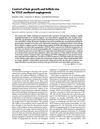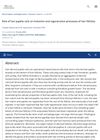TLDR Cells from the base of hair follicles help blood vessel cells survive and grow, which is important for healthy hair.
In the 2015 study, researchers found that human follicle dermal papilla cells (FDPCs) significantly contribute to the vascular remodeling of the hair follicle by enhancing the survival, proliferation, and tubulogenesis of human microvascular endothelial cells (HMVECs) more effectively than fibroblasts. FDPCs increased the release of vascular endothelial growth factor (VEGF) and insulin-like growth factor 1 (IGF-1), which are proangiogenic factors, and reduced the production of IL-1α, a negative regulator of hair growth, in HMVECs under oxidative stress. In contrast, human dermal fibroblasts had a lesser effect on HMVECs and did not alter IL-1α production. The coculture technique used was validated for studying paracrine interactions between cells related to hair follicle vascularization, indicating that FDPCs play a crucial role in supporting skin vasculature, which is relevant for hair growth and loss conditions.
1235 citations
,
December 2013 in “Nature” Two fibroblast types shape skin structure and repair differently.
51 citations
,
April 2013 in “Journal of Investigative Dermatology” Hair follicle stem cells rely on nearby blood vessels for their maintenance and function.
120 citations
,
May 2012 in “Experimental Cell Research” VEGF promotes hair follicle cell growth through the VEGFR-2/ERK pathway.
 520 citations
,
February 2001 in “Journal of Clinical Investigation”
520 citations
,
February 2001 in “Journal of Clinical Investigation” VEGF helps hair grow and determines follicle size by increasing blood vessel growth.
 January 2022 in “Journal of St. Marianna University”
January 2022 in “Journal of St. Marianna University” Substances from human hair cells can affect hair loss-related genes, potentially leading to new treatments for baldness.
 15 citations
,
April 2014 in “Experimental Dermatology”
15 citations
,
April 2014 in “Experimental Dermatology” Scientists developed a system to study human hair growth using skin cells, which could help understand hair development and improve skin substitutes for medical use.
 321 citations
,
December 2009 in “Journal of Dermatological Science”
321 citations
,
December 2009 in “Journal of Dermatological Science” Dermal cells are key in controlling hair growth and could potentially be used in hair loss treatments, but more research is needed to improve hair regeneration methods.
32 citations
,
August 2006 in “Archives of Dermatological Research” Dermal papilla cells can help regrow hair follicles.
January 2003 in “Chinese Journal of Reparative and Reconstructive Surgery” Dermal papilla cells can help form hair follicles and produce hair.
 66 citations
,
August 2001 in “Experimental Dermatology”
66 citations
,
August 2001 in “Experimental Dermatology” Human hair follicle cells can grow hair when put into mouse skin if they stay in contact with mouse cells.
 57 citations
,
November 1998 in “Wound Repair and Regeneration”
57 citations
,
November 1998 in “Wound Repair and Regeneration” Hair papilla cells can create and regenerate hair bulbs under the right conditions.






